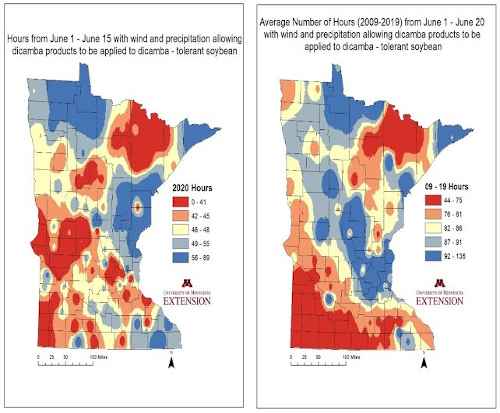By Jared Goplen and Dave Nicolia
Timely pesticide applications have been a challenge in 2020. So far in the month of June, much of Minnesota has had notably few hours that would be considered “ideal” for pesticide applications. The biggest issues have been the abnormally windy conditions, coupled with very calm (<3mph) winds that favor temperature inversions. There have been reports of some unusual “off-target” herbicide issues this spring that are likely due to conditions being either 1) too windy, or 2) very calm (<3 mph) conditions with temperature inversions or variable winds.
How many “ideal” pesticide application hours have we had?
Earlier this week I was asked how many hours we have had throughout Minnesota to legally apply dicamba products to dicamba-tolerant (DT) soybeans in 2020. If you are familiar with the label requirements to apply dicamba products to DT soybeans, you know there are very specific requirements. Several weather-related requirements include:
- Do NOT apply when temperature inversions exist.
- Do NOT apply earlier than 1 hour after sunrise or later than 2 hours before sunset.
- Do NOT apply unless wind speed at boom height is between 3 – 10 mph.
- Do NOT apply when rainfall is expected within 24 hours in amounts that would exceed field capacity.
These requirements are intended to reduce off-target movement. In general, these are also “ideal” conditions for the application of most pesticides. To calculate the number of “ideal” hours for pesticide applications (eg. the number of hours that dicamba products could be applied to DT soybeans), I analyzed weather data throughout Minnesota from June 1 - June 15. Results are presented in Figures 1-2, with the findings summarized below.
“Ideal” Application Hours behind Normal

Figure 1. Accumulated number of hours L) between June 1st and June 15th, 2020 when wind speed and precipitation allowed dicamba applications to made to dicamba-tolerant soybeans, and R) the 20-year average number of hours when wind speed and precipitation would allow dicamba applications to be made to dicamba-tolerant soybeans. Only hours between 1 hour after sunrise and 2 hours before sunset are included. Weather data from ASOS weather stations was downloaded from https://mesonet.agron.iastate.edu/request/download.phtml?network=MN_ASOS

Figure 2. 2020 deviation from the 20-year
average for the number of hours from June 1st –
June 15th with wind and precipitation allowing
dicamba applications to be made to dicamba-
tolerant soybeans.
- The number of ideal application hours in Minnesota ranges from 0 – 89 hours, depending on location, with an average of 47 hours between June 1st and June 15th (Figure 1).
- 97% of the state is behind the 20 year average for the number of ideal application hours, although 38% of the state is within 20% of normal (Figure 2).
- Much of Central Minnesota has had particularly few (<40) hours of ideal application conditions.
Windy June (or Not?)
Much of Minnesota has experienced windier conditions than normal this month which have made applications difficult. An equally important issue at some locations has been the lack of wind (<3mph), which favors temperature inversions.
Inversions can “trap” pesticides within a stable air layer, which allows longer-distance transport of pesticides.
To reduce off-target movement, most pesticide labels cite that products should not be applied during windy conditions nor during low wind conditions (<3 mph) that favor inversions and variable winds.
The windy conditions this month have made timely pesticide applications challenging. When the wind finally does go down, it's equally important to keep low wind speeds and temperature inversions in mind, as particle drift can occur under these conditions, as well.
For more information regarding drift and the influence of the wind, visit the recent article from Andrew Thostenon at NDSU: https://www.ag.ndsu.edu/cpr/weeds/drifting-in-the-wind-06-18-20
For more information regarding temperature inversions, visit a previous University of Minnesota Crop e news article at:
https://blog-crop-news.extension.umn.edu/2017/06/temperature-inversions-something-to.html
Summary
This has been a challenging year in making quality pesticide applications in a timely manner. Eliminating off-target movement of pesticides is the goal. Applicators should do their best to avoid applications during windy conditions. Off-target movement can also happen with low wind speeds, especially under temperature inversions. Be sure to consult with product labels for recommendations and application requirements. Application equipment can also be tailored to minimize off-target movement by using larger droplet sizes, shielded booms, and lower boom heights.
Source : umn.edu